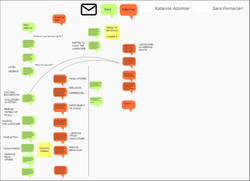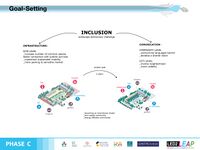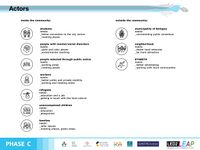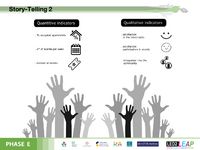LED2LEAP 2021 - Bologna Team 1
>>>back to working groups overview
For help with editing this Wiki page use this link.
For assignments and key readings use this link.
Landscape Democracy Rationale
“The goal was to inspire a transformation of landscape planning education both at the European level and within the partner universities, engender a new culture of engagement and social responsibility, and prepare students to serve as catalysts of democratic landscape change across cultures andgeographical contexts”. Ruggeri, D. (2019), The What, Why and How of Landscape Education for Democracy, in_bo, vol. 10 n. 4, (https://doi.org/10.6092/issn.2036-1602/9844).
Our goal is to collaborate with the community to know its peculiarities, but also the landscape and social injustices, trying to involve the different stakeholders. Keeping in mind how democracy, social justice and participation are important in landscape architecture and planning education.
Location and Scope
Salus Space, Bologna
The themes on which the Salus Space project is focused are: social inclusion of migrants and refugees, urban poverty, energy transition, development of new jobs. The general objective of the project, lasting 3 years, is the integration in the local context of a center of hospitality, work, intercultural welfare and well-being in the broad sense.
To be involved are the area and buildings of the former private clinic called "Villa Salus", which for many years have been in a state of neglect and decay. The project, in its entirety, is accompanied by a strong communication campaign aimed at the city, a participatory communication, which involves both the project partners and the community of inhabitants of the area.
Salus Space wants to define an innovative model of hospitality and integration, which can be replicated in other European contexts.
Phase A: Mapping Your Community
Welcome to Your Community and Their Landscape
Salus Space is located in the eastern part of the municipality of Bologna, Italy. The location is quite far form the city centre: for this reason it is hard to get to it, especially with public transport or by bike. However, the location permits to get in touch with the nature which characterizes all the neighborhood.
If we look to the surroundings of the Salus Space, we can notice the strong presence of green areas and the Savena river. The area is also characterized by the presence of one of the biggest military areas of the city and the big 60s' neighborhoods.
The project of the Salus Space is a working project. Today the area is not in its final configuration but it is in a temporary configuration which will last for 2 years from the beginning of April 2021. This period is a testing period when all the stakeholders will progressively give all the power to the community itself. It is also a testing period to implement the area with all the functions which will permit the sustenance of the community.
The challenges of the community are about the relationships inside the community itself and the relationships between the community anche the neighborhood/city. This project wants to be a model for Italian and European zero waste communities and this is really challenging.
Groups of Actors and Stakeholders in Your Community
Groups of actors that are involved in the project, can be divided into actors whitin the comunity and external actors.
The community is made up of cohousing residents that we can divide into some sub-communities: the people selected through a public notice and the students of the University of Bologna are the most active members who share the sense of belonging to something. Other members have yet to arrive in Salus such as those who come from the humanitarian corridors or the workers from ETA BETA. The relationship between these very various groups is one of the democratic challenges.
The external actors are also divided into sub-groups that work on the development of the project. The monitoring commitee is leaded by the munincipality of Bologna that has the task of monitoring progress. The more active gruop is the managing agent made by a temporary union of associations leaded by ETA BETA, which is in carghe of coordinating the various activities that make up the project.
Salus Space comunity the community aims to become a model of life fully inserted in the society of Bologna.
Relationships Between Your Actors and Groups
There are many subjects who have worked for the conception, implementation and support of this project, including those represented in the images below.The municipality of Bologna was the first to participate in the implementation and is currently responsible for supervising and coordinating the project. While the ATS deals with the management of the economic and social activities envisaged by the European project. The inhabitants, on the other hand, through the assembly tool, take care of the management of the common spaces and modify the points of the rules of collaborative coexistence.
As for the relationships that have been established within the community, it is not yet possible to give a precise picture, as the first inhabitants entered at the beginning of April, still six apartments are not inhabited but the ideas proposed by the community show a proactive attitude. The future desire to create spaces and events that involve the community is part of all the subjects who were interviewed.
Summary of Your Learnings from the Transnational Discussion Panel
Having the opportunity to meet the communities is not obvious. We had to take care of the moment to obtain the information necessary to set up the collaboration, remembering that the key is to weave a network of relationships. It is important to show all the material we had the possibility to analyze (photos).
The debate with students and designers from other European realities was useful for learning about new ways of working towards communities and the landscape. It was interesting to be able to see how many landscape democracy challenges can be found in different contexts.
An interesting advice, emerged during the discussion, is to write something about the main topics of this project. In this way, we can have a deeper understanding and reflection about what we do and what we see.
Theory Reflection
During this phase A, we have found some difficulties linked to the fact that the community is very recent and not completed at this moment. Moreover, it is not so easy to organize meetings due to the COVID-19 restrictions and to interact with some members of the community.
We would like to use the keywords highlighted as starting point to continue our research and develop the concept within the LED2LEAP’s scopes.
References
- http://www.saluspace.eu/
- Council of Europe, Landscape Convention Contribution to human rights, democracy and sustainable development, 2018
- Randolph Hester, Design for Ecological Democracy, 2006
- LED Team, Landscape Education for Democracy, in InBo Special Issue, 2019
Phase B: Democratic Landscape Analysis and Assessment
Alberto Grassetti and Antonia Čubelić Correspondence
Me and Antonia strade writing form the first session of the B phase. We used real formal layouts and it was quite funny and we liked it. Our correspondence started with greetings and knowing each other: we talked about our LED projects and our university studies, about our hobbies and our exceptions for the future. This first part was really useful because in the second part, after having read the bibliography we could spend some words related to our projects and our lives. After the second session of the B phase we start reading the chapters ("Why community matters?", "At the boundaries", "Design as democracy" 2nd chapter). This kind of correspondence was quite useful and challenging to us especially because it requires a lot of time to write down in a good way our thoughts about the topics and the bibliography. This is perfectly coherent with one of the most important themes we discussed about which is reflection and this kind of layout was optimal for that. This correspondence gave us the opportunity to get in touch with a different culture, a different case study and gave us a lot of stimuli to deeper our thoughts about participation and democratically challenges in our projects.
Sara Fornaciari and Katarina Adulmar Correspondence
Katarina and I started the email correspondence by trying to know and discover the landscapes and communities we are working with. Beginning to read the assigned texts, we then discovered many common points, although the places and challenges were different. We have reflected on the prejudices reserved for people who share a place but come from very different cultural and family backgrounds and what effects affect the landscape. We then agreed that it is necessary to include teachings in our study paths that too often tend to favor technical or artistic knowledge instead of the human sphere. The exchange allowed us to analyze the challenges of the respective projects with a new perspective, which is why we decided to stay in touch
Francesca Pinotti and Gabrijela Hercigonja Correspondence
Gabrijela, who studies at the University of Zagreb, and I have initiated our correspondence by e-mail. We then chose to use Facebook as a platform, because it was easier and faster to communicate. We reflected on the articles that were assigned to us, at the beginning on “Design as Democracy” which we found the most interesting text, especially for the approach towards the community. We continued to chat about other articles and, in general, about the different approach our universities take when starting to design. Our thoughts and impressions on the proposed arguments were very similar and it was very productive and stimulating to discuss them together.
Phase C: Collaborative Visioning and Goal Setting
The Actors in Your Story of Visioning
The SalusSpace co-housing experience is very recent, it started on april 2020 and has set some inner goals: becoming and international model for others communities, becoming a zero-waste community, becoming an energy efficient community. The project itself had already a plan for its growth, but this design doesn't involve the most important landscape democracy challenge: INCLUSION. It is related both to the infrastructure either communication. Both of them have multiple declination: the site need a better connection with Bologna but also to resolve some inner problems refer to the common spaces. At the level of communication the project lack of visibility in the society of Bologna and becaous of various people that are involved there also a little language barrier.
We divided the actors in two groups: the community's members who are very differents from each others so the put on the table a lot of different problems and points of view. On the other hand to transform our goals into concreate actions we need to deal with many subject out of the community such as the munincipality but also the union of cooperative leaded by ETA BETA.
Any of them are interested in different things, but we find out about similar goals which can be pursue and can satisfy almost everyone. This analysis highlighted that the need for a good infrastructural connection and the growth of the project visibility within the city represent the priority.
The Story of Visioning
Through the encounter with the community, we understood the importance of the Salus Space Market. This event allows to bring people from the city into this space and make it known better. The market sells fruits, vegetables, but also unpackaged products so it is important because permits to create a sense of responsibility in people to sustain the theme of a circular economy. Currently, this event isn’t well known by people, so we thought about a slogan to promote it, especially on social media and also through leafleting.
To bring people from the city to this space we thought about a shuttle train that connects the city centre of Bologna to the Market, and this prevents the problem of parking areas, which are missing. We planned by a timeline a possible example of activities for promote and make the market increase, like create some theme events, create an educational workshop for school and elderly, and in the future use in the Salus Space Restaurant, the products are grown in the vegetable garden.
Reflect on Your Story of Visioning
It is not certain that all proposed ideas will be implemented due to feasibility. For this it is necessary to think of a possible "Phase B" in which only some of the advanced ideas will be realized. To formulate the objectives we have given particular emphasis to the concept of “flexibility”.
In particular, the area in question presents problems relating to the connection with the city center due to the lack of pedestrian and cycle paths, parking lots and bus stops. Obviously, there are many actors and costs involved in solving these problems. For the moment we have focused on trying to connect the Salus Space to the city. This does not mean that the problems encountered do not need to be solved in the future.
The goal is to research with the community what are the strengths and weaknesses and, through a shared vision, to think of ideas. Maintaining a vision aimed at the present, to solve problems, but always with an eye to the future.
Phase D: Collaborative Design, Transformation and Planning
Your Prototyping Action
Before getting in touch with the prototype we need to understand what's happening inside the community if Salus Space. Salus Space is located in the easter part of the city of Bologna and it's quite hard to get to it. The space of the community has different functions and activities such as a garden for hydroponic agricolture, a local product market place, a space for theatre workshops. In front of the houses there's a big green area to organize with different activities and this is the main challenge we are fronting with the prototype: our goal is to understand how to organize this area and which activities fit the most here.
The Evolution of Your Prototyping Action
The prototype thought was that of a questionnaire (multilingual) in order to be able to overcome the problem of not understanding the Italian language.
Obviously, the survey on Mural proposed during the activity with the other students of the various universities is simplified in order to make the activity more playful, interactive and effective.
The various figures currently present at Salus Space have been identified, generalizing. Each student was able to impersonate himself in the chosen figure and respond accordingly to the questions posed in the questionnaire.
In the final phase, the information collected and represented graphically through schemes was collected. Students are also asked to insert their proposals, through an icon, directly on the map. In this way, it was possible to understand immediately the possible desires and possible needs.
The Plan Behind Your Prototyping Action
Initially, the goal was to physically meet the community to propose an interactive game. Therefore it was decided to create this survey to see the response not only of the community but also of our colleagues and understand their strengths and weaknesses of the ideas proposed.
The Realization of Your Prototyping Action
To realize the questionnaire, the two teams from Bologna met for a long time. not being able to see each other physically, we made video conference meetings to be able to compare and arrive at a final idea that could satisfy all the participants.
Reflect on Your Prototyping Action
The response from students from other universities was very satisfying and they seemed quite involved in this idea. also by the interactive modality of autonomously inserting any project ideas in the area. This has given us many insights to use in future meetings with the community.
Phase E: Collaborative Evaluation and Future Agendas
Collaborative Evaluation and Landscape Democracy Reflection
Salus Space, as we've seen, it's located in a suburban area of the municipality of Bologna. Due to its location, it is fundamental for the community to get in touch with the neighborhood and to attract people from the city with a better advertising. Our main challenge is about the project of the central green area of the community which today is empty. Due to its nature, the community already has different functions which are part of the whole project. But we should ask the following questions to develop this green place: how to organize the green space il Salus Space square?; which activities fit the most?; which functions are better for the community?; how to get the neighborhood involved in the activities of the community?; how to implement the relationships inside the community and between the community and the neighborhood?
The Actors in your Collaborative Evaluation
To better understand the whole process and how to develop a collaborative project it's fundamental to analyze the different actors involved during the process. We've identified different actors which take part to the process in different moments and whit different goal and need. These are: the community; Elena; the lawyer; us as designers; the neighborhood.
The process is divided in three main steps which are: the survey so we can understand the community sub-groups types and the needs and aspirations of everybody; the data return so we can discuss all together about the result of the survey anche choose some activities to use during the workshop; the mapping workshop so we can decide with a game how to organize the area and draw the function map of the green space. Each actor takes parte in one or more moments in different places.
Reflection on the Online Seminar
The online seminar was very useful and effective because it allowed us to receive different points of view from other figures. Especially during the various phases of the "Murals" and during the presentation of the prototype, suggestions were made that were useful to us in the following phases.
Reflection on the Living Lab Process
It was not easy to organize meetings with the community as it has to be approved in the meeting they have once a week. We have therefore submitted to them a questionnaire currently in an online form (but which can also be completed in paper form).
This survey involves the completion of various phases. Initially, we will try to draw up a profile of the people (despite being anonymous) and we will try to collect information on the relationship with the other inhabitants of the community, on mobility, on how they spend their free time and on the future. All these collected data will be processed and will be useful for understanding the needs and being able to operate some project ideas, perhaps through a game to be played with the community.
Through this survey, we will certainly obtain outputs from the community that will allow us to identify future changes and implement strategies. We have also indicated at the bottom right a map with the ideas obtained from the answers of the questionnaire submitted to the other students during phase D, which could be similar to that of the community.
The outcomes of this process will be very important, that is the well-being of the community, the satisfaction of the users, the resolution of possible problems, the social interaction between the various actors of the community and in general also the perception of the users.
Finally, we have shown the main indicators that will be the cornerstones in our analysis (especially regarding the answers obtained in the questionnaire). We have divided the indicators into two macro-themes: quantitative indicators and qualitative indicators. In the former, we find the percentage of occupied apartments (since in the first meeting with the community more than half were empty, we want to evaluate the change that has taken place in these 2 months). The number of events that have taken place and the participation fee.
As regards the qualitative indicators we will try to investigate the degree of satisfaction of the inhabitants for the place where they live and the events in which they participated. And the degree of integration in the community.
Your Living Lab Code of Conduct
The game of mapping consist of 4 steps: making a list of events, activities and equipment from the answers of the survey; then during a workshop divide the participants into groups, making sure that each teams has at least one residents, because in our idea the neighborhood that has free access to the public garden needs to be involved too. To play they will have to place a physical mark in the sort of chess that shapes the garden, if the palce is already occupied by another team it will be the subject of a negotiation between the teams. The result of this experience is the concrete design already p placed in the space of the activities, that allows us to also understand any relationships and contrast between them.
the Salus Space community is bound to change over the years with the advent of new people, with their own desires and ambitions: it is a dynamic community. Now we have to play the workshop with the actual inhabitans both of Salus and the neighborhood; in the following weeks the result is to be submitted to the attention of the actors who hold a part of the decision-making power on the future of Salus: residents, municipality, union of associations, lawyer who is the link between the community and istututional part. In the following months monitoring the livability of Salus and the functionality of the landscape submitiing the questionnaire to the new inhabitants and compare the previous answers.Alongside this tool, the photograph of what has been obtained from the workshop can also help monitor the development of the transformation.
Process Reflection
the most important indicators for this process are:the number of future events that the community will be able to organize and carry out, as well as the number of occupied apartments. This two indicators gives us a data about the quatity of people involved, but also if the community keep on being active and interesting. To understand the quality of life in Salus and the quality of the proposed transformations it is necessary to focus on the number of participants and on the results of the questionnaire. What would we change about the process we planned? The community is rather small, there are 13 two-room and three-room apartments (about thirty inhabitants in all) for this reason it is important for a democratic process to collect everyone's opinion, however precisely for this need it is necessary at the beginning of the process planning a calendar of meetings that follows the development of the various stages as closely as possible to avoid overlapping with everyone's events and commitments and excessively postpone work.



























